I'm trying to plot my data on a log-log scale, using Theil-Sen regression for the best fit line. However, when I plot work out my regression line on a log-scale 2, it's parallel to my x=y line, which I don't think is correct.
normal scale for X and y :
log-log scale for X and y :
I found a related solution by chaooder for Linear Regression on a semi-log scale to be somewhat helpful. So currently, my regression line would go from being:
y = ax + c on a linear scale to y = 10^^(a log(x)+c) on my log-log scale. But in my head, I can't understand how that has a solution as I cannot calculate a.
Here's the data:
index,x,y
0,0.22,0.26
1,0.39,0.1
2,0.4,0.17
3,0.56,0.41
4,0.57,0.12
5,0.62,0.54
6,0.78,0.99
7,0.79,0.35
8,0.8,0.33
9,0.83,0.91
10,0.95,0.81
11,1.08,0.23
12,1.34,0.11
13,1.34,0.44
14,1.35,0.11
15,1.58,0.24
16,1.66,0.71
17,2.11,0.54
18,2.13,0.42
19,2.19,1.72
20,2.25,2.16
21,2.39,0.95
22,2.4,0.16
23,2.73,0.92
24,2.87,1.1
25,2.96,0.27
26,3.12,1.66
27,3.26,0.06
28,3.28,0.68
29,3.34,0.7
30,3.38,1.14
31,3.39,1.81
32,3.41,0.19
33,3.49,1.4
34,3.52,1.57
35,3.6,0.99
36,3.64,1.28
37,3.65,1.68
38,3.89,1.66
39,3.93,1.64
40,4.01,1.04
41,4.07,0.32
42,4.22,0.68
43,4.52,0.57
44,4.53,0.59
45,4.56,0.7
46,4.6,1.15
47,4.62,1.31
48,4.68,1.09
49,5.03,0.48
50,5.06,0.7
51,5.31,0.62
52,5.41,0.21
53,5.45,2.06
54,6.0,0.72
55,6.06,0.36
56,6.64,1.41
57,6.74,0.59
58,6.96,0.95
59,7.01,1.13
60,7.14,1.56
61,7.14,2.82
62,7.19,1.49
63,7.21,0.88
64,7.23,1.31
65,7.55,0.76
66,7.72,0.5
67,7.75,1.65
68,7.77,1.48
69,7.9,1.8
70,7.95,0.68
71,8.03,1.12
72,8.09,2.61
73,8.86,1.71
74,9.31,0.23
75,9.5,2.35
76,9.62,1.84
77,9.91,0.56
78,9.95,1.67
79,10.4,1.15
80,10.8,0.88
81,11.28,1.8
82,11.31,1.58
83,11.43,1.0
84,12.38,2.83
85,13.38,1.45
86,13.9,1.99
87,30.3,1.99
And my current code:
import pandas as pd
import numpy as np
import matplotlib.pyplot as plt
from matplotlib.ticker import AutoMinorLocator
from sklearn.linear_model import TheilSenRegressor
for log in [True, False]:
fig,ax = plt.subplots()
data.plot.scatter(ax=ax,
x='x',
y='y',
loglog=log)
vmin = np.amin(data[['x','y']].min().values)*0.8
vmax = np.amax(data[['x','y']].max().values)*1.25
ax.set_xlim(vmin,vmax)
ax.set_ylim(vmin,vmax)
ax.yaxis.set_minor_locator(AutoMinorLocator())
ax.xaxis.set_minor_locator(AutoMinorLocator())
# best fit (ThielSen) line
X = data.x.values[:,np.newaxis]
y = data.y.values
if log:
X = np.log10(X)
y = np.log10(y)
if len(y) > 0:
estimator = TheilSenRegressor(fit_intercept=False) # intentionally set intercept to 0
estimator.fit(X=X,y=y)
y0 = y[0]
x0 = X[0]
y_pred = estimator.predict(np.array([vmin,vmax]).reshape(2,1))
# y_pred = np.power(10,(estimator.predict(X)))
gradient = (y_pred[1] - y_pred[0]) / (vmax - vmin)
intercept = y_pred[1] - gradient * vmax
print(f'gradient: {gradient} \n intercept: {intercept}')
# Theil-Sen regression line
ax.plot([vmin,vmax],y_pred,color='red',lw=1,zorder=1,label='Best fit')
# 1:1 ratio line (black, dashed)
ax.plot([vmin,vmax],[vmin,vmax],lw=1,color='black',ls='--',alpha=0.6,zorder=1,
label='1:1 correlation')
if log:
ax.set_xscale('log');ax.set_yscale('log')
ax.set_title('log-log scale')
fig.savefig('TS_regression_loglog.png')
else:
ax.set_title('normal scale')
fig.savefig('TS_regression_normalscale.png')


